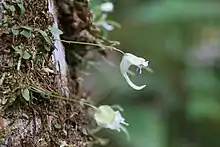Utricularia jamesoniana
Utricularia jamesoniana is a small perennial epiphyte carnivorous plant in the family Lentibulariaceae. It is native to Central America, the Antilles, and northern and western South America. Specifically, it can be found in Bolivia, Brazil, Colombia, Costa Rica, Ecuador, French Guiana, Guatemala, Guyana, Nicaragua, Panama, Peru, Suriname, and Venezuela and on the islands of Guadeloupe, Hispaniola, Dominica, and Martinique. The species was originally published and described by Daniel Oliver in 1860. Its habitat is reported as being mossy tree trunks in montane cloud forests or lowland rain forests at altitudes from sea level to 2,500 m (8,202 ft). It flowers year-round.[2]

Flower
| Utricularia jamesoniana | |
|---|---|
 | |
| At Puyo, Ecuador | |
| Scientific classification | |
| Kingdom: | Plantae |
| Clade: | Tracheophytes |
| Clade: | Angiosperms |
| Clade: | Eudicots |
| Clade: | Asterids |
| Order: | Lamiales |
| Family: | Lentibulariaceae |
| Genus: | Utricularia |
| Subgenus: | Utricularia subg. Utricularia |
| Section: | Utricularia sect. Orchidioides |
| Species: | U. jamesoniana |
| Binomial name | |
| Utricularia jamesoniana | |
| Synonyms | |
See also
References
- Clarke, C.M. (2018). "Utricularia jamesoniana". IUCN Red List of Threatened Species. 2018: e.T107413007A144005813. doi:10.2305/IUCN.UK.2018-1.RLTS.T107413007A144005813.en. Retrieved 19 November 2021.
- Taylor, Peter. (1989). The genus Utricularia - a taxonomic monograph. Kew Bulletin Additional Series XIV: London.
This article is issued from Wikipedia. The text is licensed under Creative Commons - Attribution - Sharealike. Additional terms may apply for the media files.
